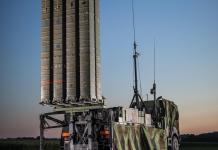In response to recent attrition due to successful interceptions by US-supplied Patriot Air Defense (AD) missiles, Russian Su-34 pilots have apparently adapted new tactics for delivering FAB UMPC bombs.
4 Reasons Why China’s Xi Jinping Has Taken ‘Direct Control’ Of Military & Disbanded ‘Much Hyped’ SSF
A video published by the Russian Ministry of Defense (RuMoD) on April 22 depicts Su-34 crews purportedly destroying an enemy command post and manpower in the South Donetsk direction. The strike was executed using high-explosive aircraft bombs equipped with a universal planning and correction module (UMPC).
A closer examination of the footage by experts reveals a significant departure from previous bombing procedures. Typically, RuMoD videos showcased Su-34 bombers dropping FAB UMPC bombs from medium altitudes in level flight, allowing for maximum standoff range while avoiding engagement with Patriot air defense systems.
However, recent events, including the downing of three Russian Su-34 attack jets on February 29 by Ukrainian forces, necessitated a tactical adjustment involving Toss bombing.
As observed in the latest video footage, Su-34 pilots seem to have adopted a hi-lo-hi profile for bomb delivery to counter the increased range of Ukrainian Patriot interceptors.
This method involves approaching the bomb release zone at low altitudes and high speeds, executing a steep climb, and then releasing the bombs at precalculated parameters to maximize range while minimizing exposure to adversary AD (Area Denial) systems.
Toss bombing, typically associated with the delivery of dumb nuclear bombs for maximum range, now appears to be employed for FAB UMPC (the Fugasnaya Avia Bomba, meaning Aerial Demolition Bomb) attacks.
Su-34s reduce the risk of radar detection and long-range missile engagement by utilizing a high-speed, terrain-hugging approach. According to military analyst Vijainder K Thakur, the bombs’ ballistic trajectory during the initial phase of tossing further enhances their range while evading AD missile interception.
Despite the maneuver’s efficacy in reducing exposure to AD systems, there are concerns about increased risk during the bomb release phase. However, experts suggest that the minimal radar and heat signature of the bombs make them difficult targets for AD missiles.
The transition to toss bombing likely necessitated significant adjustments to bomb release algorithms, reflecting the adaptability of Russian air forces in response to evolving threats.
While the efficacy of these new tactics remains to be fully tested in combat scenarios, they signify a proactive effort to maintain operational effectiveness in contested airspace.
Time-Tested Toss Bombing Tactics
Toss bombing, pioneered by the US Air Force in the 1950s for nuclear weapon delivery, has evolved into a refined art over decades of military application.
The genesis of toss bombing traces back to the US Air Force’s use of Boeing B-47 bombers, later perfected by US Navy A-4 pilots. In the 1960s, Soviet Sukhoi Su-7 pilots adapted and exercised similar tactics for nuclear weapon delivery.
Subsequent applications by Israeli forces during the 1973 conflicts against fortified Egyptian and Syrian positions demonstrated the effectiveness of toss bombing in overcoming robust AD systems.
During the Iran-Iraq War and the Angolan Border War of the 1970s and 1980s, toss bombing evolved into a finely tuned art form, with various iterations and versions developed.
Despite the complexity of aerial combat environments and the sophistication of adversary defenses, toss bombing remained remarkably successful, with only a handful of aircraft ever being hit while executing such maneuvers.
The essence of toss bombing lies in the aircraft’s ascent, followed by the release of the weapon, allowing the aircraft to swiftly evade enemy defenses after release. This technique ensures that the aircraft does not overfly the target zone, maximizing its survivability while maintaining precision in weapon delivery.

Meanwhile, the efficacy of toss-bombing received a significant boost with the introduction of precision-guided munitions like laser-guided bombs. Previously, employing “dumb bombs” necessitated meticulous pilot skill and fire control computer accuracy to accurately propel the bomb towards the target.
Unguided loft bombing, often requiring larger bombs to ensure target destruction despite potential inaccuracies caused by factors like wind or errors from the pilot or computer, relied on generating a substantial blast radius.
Laser-targeting, alongside methods such as GPS utilized in systems like JDAM (Joint Direct Attack Munition is a guidance kit that converts unguided bombs, or “dumb bombs”, into all-weather precision-guided munitions), enables the bomb to adjust for minor deviations from its intended trajectory post-release, effectively equating the accuracy of toss-bombing with that of the level bombing while retaining most of the benefits of toss-bombing with unguided munitions.
Nonetheless, targeting pods employed for delivering guided munitions typically have a limited field of view, particularly when looking behind the aircraft beyond a certain angle. By lofting the bomb, the pilot can maintain the target within the targeting pod’s field of view for an extended duration by keeping it in front of the aircraft.
- Contact the author at ashishmichel(at)gmail.com
- Follow EurAsian Times on Google News




